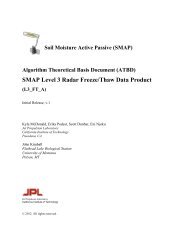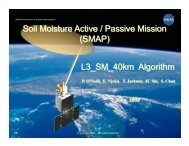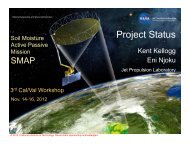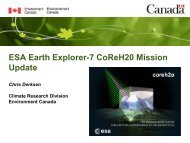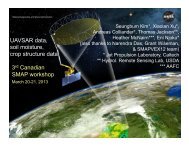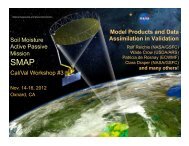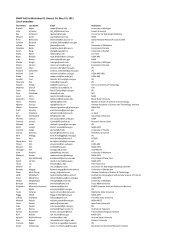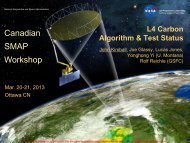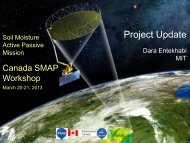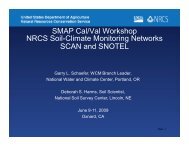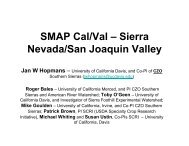(ATBD) SMAP Level 1 Radar Data Products - NASA
(ATBD) SMAP Level 1 Radar Data Products - NASA
(ATBD) SMAP Level 1 Radar Data Products - NASA
You also want an ePaper? Increase the reach of your titles
YUMPU automatically turns print PDFs into web optimized ePapers that Google loves.
57<br />
11.2.1 Backlobe Contamination<br />
GNSS interference can enter into the <strong>SMAP</strong> receiver through direct coupling with<br />
the <strong>SMAP</strong> antenna backlobes. Because the GNSS signals are constant in time<br />
(or at least constant over a synthetic aperture time), the interference can basically<br />
be treated as a rise in the background noise, analogous to a rise in the thermal<br />
noise power. In general, the GNSS interference power is actually several dB below<br />
the normal thermal noise power, so it isnt a big effect. Nevertheless, it is a<br />
non-negligible effect if not compensated for. The normal noise-only measurement<br />
and subsequent noise subtraction step provides a built in technique to remove the<br />
contamination. This technique works well where the GPS spectrum is relatively flat<br />
(i.e., in the M- and P-Code portions of the spectrum), but does not work well where<br />
the spectrum is narrow (i.e., the C-Code portion of the spectrum). It is found that<br />
direct GPS interference can be removed to 0.1 dB and 0.2 dB for the lowest co-pol<br />
and lowest cross-pol signals respectively if the spectral region around 1227.5 MHz<br />
is avoided.<br />
11.2.2 Reflection off the Earth<br />
Another mechanism of getting GNSS signal contamination into the <strong>SMAP</strong> receiver<br />
is when these signals reflect off of the Earth. Aerospace Corporation evaluated the<br />
statistics of these reflections due to the GPS constellation. The findings were that,<br />
whereas the main body of the interference distribution was lower than in the direct<br />
broadcast to backlobes case, there were non-negligible probabilities of very large<br />
interference signals (much larger than the maximum backscatter signals) when the<br />
main beam of the <strong>SMAP</strong> antenna coincided with specular points on the Earth. The<br />
probability of receiving uncorrectable levels of interference due to these specular<br />
reflections was about 2% of all the data. Of course, the Earth mostly does not<br />
behave in such a specular fashion, but the L1 processing should nevertheless have<br />
the capability of detecting and correcting or flagging these specular reflections.<br />
11.3 Summary of RFI Error Assessment<br />
At this juncture, there is no complete quantitative estimate of the error contribution<br />
due to RFI. Such a quantitative estimate would ideally describe the statistics of<br />
the residual error after the RFI has been detected and removed during ground data<br />
processing. The best that can be said at this point is: under the limitations of the<br />
current RFI environment characterizations generated thus far, the allocation in the<br />
<strong>SMAP</strong> error budget of 0.4 dB for RFI seems reasonable, assuming that it is removed<br />
using a STT technique during ground processing. In other words, no show stoppers<br />
have shown up yet in RFI analyses.



